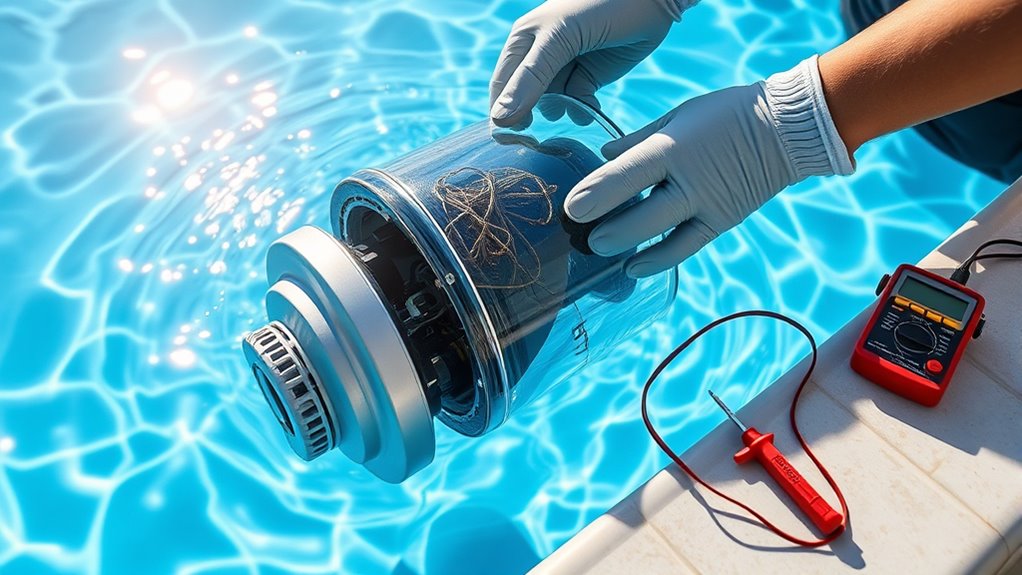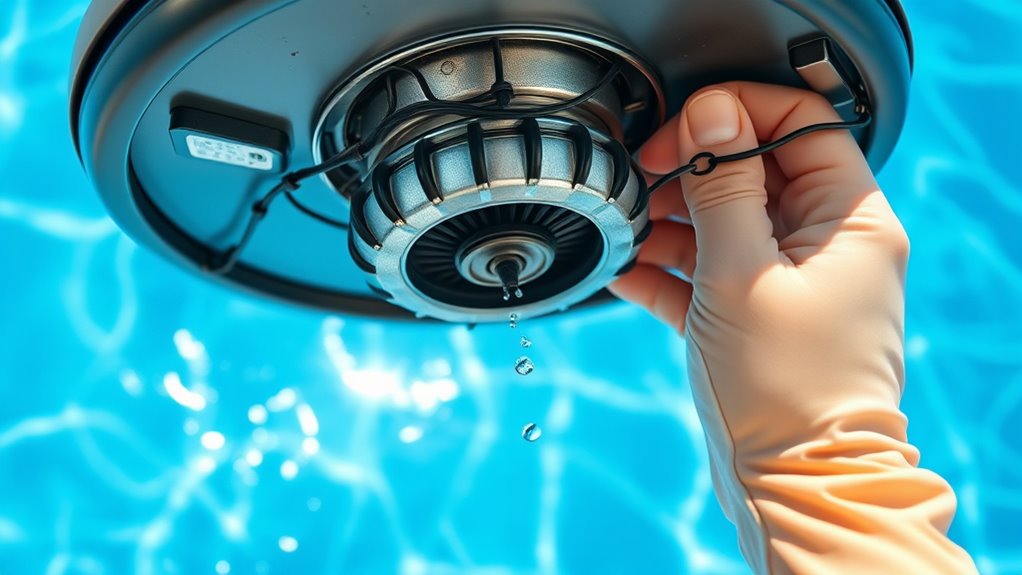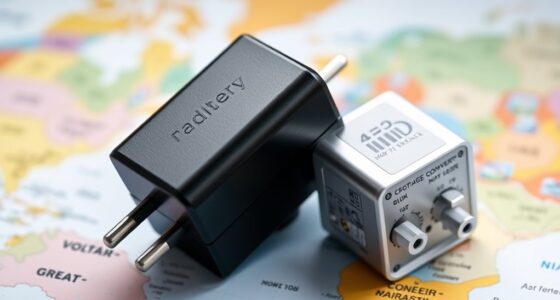If your suction pool cleaner isn’t working well, start by inspecting the hoses for blockages or kinks that restrict water flow. Check the skimmer and pump baskets for debris and clean them out. Make sure the valves are open and functioning properly. Also, test and balance your water chemistry to prevent buildup inside the cleaner and hoses. For persistent issues, exploring more detailed tips can help guarantee your cleaner runs smoothly again.
Key Takeaways
- Check and clear hoses for blockages, kinks, or debris to restore proper water flow.
- Inspect and clean skimmer and pump baskets to prevent water intake restrictions.
- Verify that all valves are fully open and functioning correctly for optimal suction.
- Balance water chemistry to prevent mineral deposits and algae buildup inside hoses and cleaner parts.
- Regularly test and maintain the cleaner’s components to ensure effective operation and prevent clogs.

A suction pool cleaner is a convenient way to keep your pool tidy, but when it stops working correctly, troubleshooting becomes necessary. One common issue is reduced or no suction, which can stem from several causes. Before diving into fixes, it’s essential to consider your pool water chemistry. Imbalanced water chemistry—like high calcium hardness or low pH—can lead to mineral buildup or algae growth that clog the cleaner’s intake or hoses. Regularly testing and balancing your pool water helps prevent these problems and keeps your cleaner functioning smoothly. Remember, safety precautions are key when working on your pool equipment. Turn off the pump and disconnect power before inspecting or repairing any parts to avoid electrical hazards or injury.
Start by checking the cleaner’s hose for blockages or kinks. A bent or clogged hose restricts water flow, reducing suction power. Clear out any debris or obstructions you find, and straighten any kinks or twists. Next, examine the skimmer and pump basket. Debris buildup here can limit water flow into the cleaner, so removing leaves, dirt, or hair can make a significant difference. If the skimmer basket is overly dirty or clogged, it’s best to clean or replace it to restore proper flow. Also, verify that the pump strainer is clean; a clogged strainer hampers water intake and reduces suction. Regular maintenance of pool equipment can help prevent these types of issues. Proper maintenance and water chemistry balance are crucial for optimal cleaner performance.
Check for blockages or kinks in the hose and clean debris from the skimmer and pump basket.
Another step involves inspecting the cleaner itself. Check the float and brushes for debris, algae, or mineral deposits. Cleaning these components ensures the cleaner moves freely and maintains proper suction. Additionally, ensure the cleaner’s inlet and outlet valves are open and functioning correctly. Sometimes, valves are partially closed or malfunctioning, which can cut off water flow. Adjust or replace faulty valves to improve performance. Furthermore, understanding the importance of regular maintenance can help prevent many common issues with your cleaner. Using advanced cleaning tools can also assist in removing stubborn deposits and keeping your equipment in top shape.
If these steps don’t resolve the issue, assess the pool’s water chemistry again. Low sanitizer levels or high contaminants can cause buildup inside the cleaner or hoses, impacting suction. Balancing the water chemistry not only ensures safety but also prolongs the life of your equipment. Proper maintenance and regular water testing are vital to prevent issues before they start. Be aware that electric power generation with bike generators can provide a sustainable energy source for pool accessories or small appliances, which might be useful during power outages or off-grid setups.
Frequently Asked Questions
How Often Should I Replace My Suction Pool Cleaner’S Parts?
You should follow a regular replacement schedule based on your suction pool cleaner’s part lifespan. Typically, you’ll need to replace parts like brushes, hoses, and seals every 6 to 12 months, depending on usage. Regular inspections help identify wear and tear early. By staying on top of part replacements, you guarantee your cleaner functions efficiently and lasts longer, saving you time and money in the long run.
Can I Use My Suction Cleaner in a Saltwater Pool?
You can use your suction cleaner in a saltwater pool, but verify its saltwater compatibility first. Some cleaners are designed to handle salt and resist corrosion, which helps with cleaner maintenance. Regularly rinse your cleaner with fresh water after use to prevent salt buildup and damage. Keep an eye on moving parts and replace worn components promptly to ensure your cleaner stays effective and lasts longer in a saltwater environment.
What’S the Best Way to Prevent Clogs in the Cleaner?
To prevent clogs in your suction pool cleaner, make sure you regularly perform filter maintenance and debris removal. Check and clean the filter basket often, especially after heavy debris storms. Remove leaves, dirt, and other debris from the pool surface and bottom before they reach the cleaner. Keeping the filter clean and the pool free of debris guarantees smooth operation and reduces the chances of clogs, keeping your cleaner working efficiently.
How Do I Store My Suction Cleaner During the Off-Season?
Did you know that improper storage can reduce your cleaner’s lifespan by up to 50%? When storing your suction pool cleaner during the off-season, follow these storage tips for seasonal maintenance. Rinse it thoroughly, remove any debris, and store it in a cool, dry place away from direct sunlight. Make sure the hoses are coiled properly, and check for any damage before storing. Proper off-season storage keeps your cleaner ready to go next season.
Is It Normal for the Cleaner to Make Noise During Operation?
You might notice operator noise and cleaning sounds when your suction pool cleaner is running, and that’s usually normal. These sounds come from the motor and brushes working to clean your pool. If the noise becomes unusually loud or strange, it could indicate a problem like debris jammed in the brushes or motor issues. Otherwise, a consistent hum or gentle cleaning sounds are typical during operation.
Conclusion
Now that you’ve got the tips to troubleshoot your suction pool cleaner, you’re equipped to keep your pool sparkling and debris-free. Remember, most issues are simple fixes that you can handle yourself—no need to call in a pro every time. So next time your cleaner isn’t working right, ask yourself: are you giving it the attention it needs? With a little patience, you’ll have your pool looking perfect in no time!










